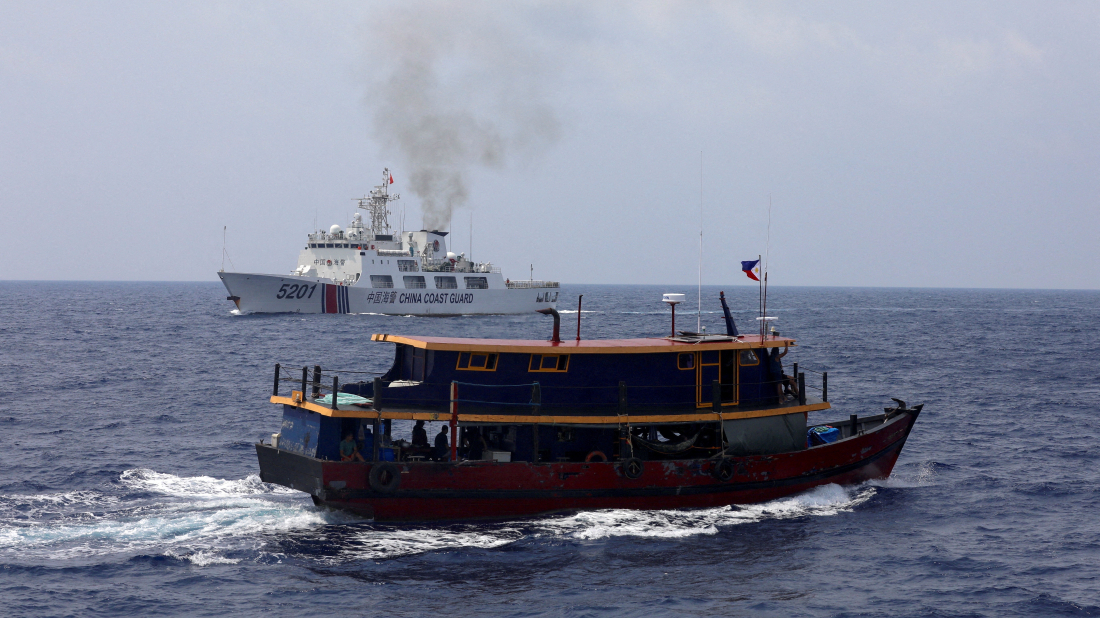Western France attacker suspected of 'self-radicalisation'
The driver who rammed his car into a crowd in western France on Wednesday is suspected of "self-radicalisation" and had "explicit religious references...

China has launched a new phase of combat readiness patrols around Huangyan Dao (Scarborough Shoal) in the South China Sea, escalating tensions in one of the world’s most contested maritime zones.
The move comes in direct response to recent joint military drills between the United States and the Philippines, and underscores the increasingly confrontational dynamics unfolding in the Indo-Pacific region.
The People’s Liberation Army (PLA) Southern Theater Command confirmed on May 31 that the patrols, involving both naval and air units, began in early May and are aimed at reinforcing what Beijing calls its right to safeguard national sovereignty and regional stability.
However, the deployment of PLA forces around Scarborough Shoal—a territory within the Philippines’ exclusive economic zone (EEZ) as defined by the United Nations Convention on the Law of the Sea (UNCLOS)—marks a direct challenge to international legal norms. In 2016, the Permanent Court of Arbitration in The Hague ruled that China had no legal basis to claim historical rights to the area, a verdict Beijing continues to reject.
A Geopolitical Flashpoint
The patrols follow closely on the heels of large-scale U.S.–Philippines joint military exercises, which included a simulation focused on retaking islands in the region—an operation perceived in Beijing as a thinly veiled rehearsal for countering Chinese advances. The temporal and geographic proximity of these maneuvers has heightened fears of miscalculation or accidental confrontation, particularly given the region’s density of surveillance and strategic deployments.
China’s use of the China Coast Guard to enforce maritime claims—through tactics like radio warnings, targeted surveillance, and vessel expulsions—has drawn international criticism. Analysts characterize these actions as part of a broader “grey zone” strategy that merges civilian, paramilitary, and military pressure to assert territorial claims without triggering outright conflict.
Strategic Implications
Scarborough Shoal lies about 220 kilometers west of Luzon, within the Philippines’ EEZ. Though China seized effective control in 2012, Manila and its Western allies—including the U.S., which is bound to the Philippines by a mutual defense treaty—continue to press for the shoal’s demilitarization and for the enforcement of the 2016 legal ruling.
The latest PLA operations reflect a calculated effort to reshape the strategic status quo, projecting power across disputed waters and signaling resolve against regional cooperation efforts championed by ASEAN nations and Western powers.
Military analysts warn that China’s approach—characterized by incremental territorial control and rejection of international arbitration—marks a shift from law-based maritime governance to power-based assertion. The PLA’s visible presence around Scarborough Shoal is not only symbolic but also operational, enhancing Beijing’s deterrence capability and complicating freedom of navigation efforts by other states.
Outlook
With the U.S. reaffirming its defense commitments to the Philippines and regional military activity intensifying, the South China Sea appears set for a period of heightened tension and strategic brinkmanship. While open conflict remains unlikely, the increasing pace and complexity of interactions between rival forces raise the stakes in one of the world’s most critical maritime corridors.
The Champions League match between Qarabağ FK and Chelsea ended 2–2 at the Tofig Bahramov Republican Stadium in Baku, Azerbaijan on Wednesday (5 November).
Brussels airport, Belgium's busiest, reopened on Wednesday morning after drone sightings during the previous night had resulted in it being temporarily closed, although some flights remained disrupted, its website said.
A French court has postponed the trial of a suspect linked to the Louvre jewellery heist in a separate case, citing heavy media scrutiny and concerns about the fairness of the proceedings.
Russia remains in constant contact with Venezuela over tensions in the Caribbean, Kremlin spokesman Dmitry Peskov was quoted as saying on Tuesday.
U.S. federal investigators have recovered the flight recorders from the wreckage of a UPS cargo plane that crashed and erupted in flames during takeoff in Louisville, Kentucky, killing at least 12 people and halting airport operations.
The driver who rammed his car into a crowd in western France on Wednesday is suspected of "self-radicalisation" and had "explicit religious references" at home, the country's Interior Minister Laurent Nunez said on Thursday.
Start your day informed with AnewZ Morning Brief: here are the top news stories for the 6th of November, covering the latest developments you need to know.
U.S. President Donald Trump urged New York City mayor-elect Zohran Mamdani to be "nice" to Washington, saying he approves "a lot of things" for the city and that the Democrat’s election-night remarks showed an "angry" tone toward him.
Ten percent of flights at 40 major American airports could be cut from Friday (7 November) if the U.S. government shutdown continues. Transportation Secretary Sean Duffy and the FAA Administrator Bryan Bedford made the announcement on Wednesday.
U.S. Supreme Court justices expressed scepticism on Wednesday about the legality of President Donald Trump’s wide-ranging tariffs, in a landmark case that could have major consequences for the global economy and test the limits of presidential power.
You can download the AnewZ application from Play Store and the App Store.

What is your opinion on this topic?
Leave the first comment